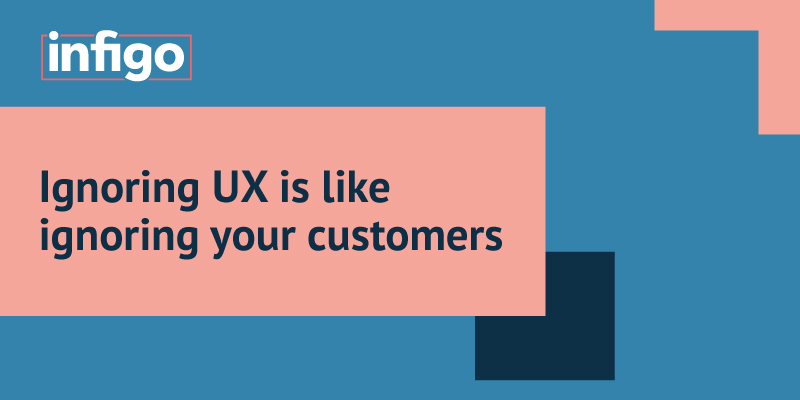We understand the importance of UX and what a difference a successfully designed and executed UX can bring to a business, which is why we sent our Lead Front End Developer to the London UX Conference 2019. A large part of our motivation at Infigo has always been, and will always remain, to continually improve what we are able to offer our clients and how best we can react to the needs they have and the, often expansive, requests to develop our capabilities to meet the evolving requirements of their customers. Our industry, just like our company, demonstrates constant evolution; what is impossible today, may be possible tomorrow and old news next week.
A critical part of the evolution of ecommerce and web based industry is User Experience, or UX. Designer Frank Chimero sums up the importance of UX perfectly, ‘People ignore design that ignores people’. What we do, how we build our sites and develop our software is driven by the need to offer the most engaging UX possible, so that clients and their end users are able to achieve the results they’re after with the most logical and user friendly journey.
In our efforts to really drive our thoughts on UX and motivate us to stay ahead of the curve we have given Ricky Forizs, our Lead Front End Developer, the freedom to explore the cutting edge of UX thought and in turn drive our company forward.
So what did Ricky learn (& I’ll be honest here – he’ll kill me for saying he ‘learned’ all this, as I suspect he knew it all already!)
UX must be considered more than just the journey an online user experiences. UX lies at the heart of all interactions across all departments of a company. A UX designer needs to create a solution that all individuals in all departments, regardless of capability, experience or knowledge, are able to successfully navigate and interact with.
This is enabled by a detailed breakdown of all areas of UX, running detailed analysis of UX journeys as recorded by heatmap analytics software. The benefit of this technology allows a designer to identify common areas of concern that cause multiple users to either stumble, pause or dropout of the page they are on. With the resultant data from heat map analysis, a UX designer can survey potential users as part of an R&D project to influence the decisions that will inform the next version of their software. With the subsequent test runs and the feedback generated, it is possible to have an informed design decision based on real time and real person feedback. Communication of this process is key in creating an understanding of why certain decisions and processes have been arrived at.
Seen through this prism, essentially, UX is an R&D exercise that provides solutions to known and previously undiagnosed problems. From the designer’s perspective, when these solutions are being developed it is key that they maintain a record of the UX journey that existed before the new development. Without such a record it would be impossible to have a genuine ‘compare and contrast’ record of events and be able to reach a satisfactory conclusion of success or not.
A simple example of how a considered UX development based on real time, real user data can drive success and conversions was provided by Francesca Granato. Francesca identified that a greater conversion rate was generated by a trust based, developed UX journey, over that of a marketing designed UX journey.
Imagine you land on a page that has a pdf download file that you desperately need/want. Logic may suggest that the download button be placed at the bottom of the page so that a user is forced to scroll down, through the info that the page really is trying to sell to you. The user scrolls through the page paying little if any heed to its content, eager just to reach the download.
Now imagine the same page, but the download button appears front and centre at the top of the page. The user is not forced to scroll through what they know to be a marketing and advertising script. Instead they hit download immediately. And then what?! Whilst they wait for the download they read the page content at their leisure believing they have chosen to read this content. This is the crucial point – they believe they have chosen to read the content and have not been forced too. This generates trust that converts into sales. A simple but effective use of clever UX design.
Consider this alongside the story told by Morten Post Lüneborg. His experience at Lego taught him a crucial lesson about engagement and customer satisfaction. Simply put, if instruction provided was exact and too precise, and Lego pieces provided were equally exact with no spares, then a user would construct their product and once completed would habitually, leave the construction complete and not return. He and his colleagues realised that there was little if any room for imagination and play in the truer sense of the word. By introducing extraneous pieces and leaving room for a little ambiguity in the instructions, his team realised that users were more likely to play with the Lego more, create constructions that were spontaneous and return to the product more often. In short they identified a way to stimulate imagination and play. This of course provides a great user experience of the Lego and chimes with the methodology defined by Steve Jobs, ‘You’ve got to start with the customer experience and work back towards the technology – not the other way around’.
We can take from this the need to allow our products, such as the MegaEdit tools, to remain places where users can allow their imagination to be stimulated, to not be so prescribed as to be restrictive.
